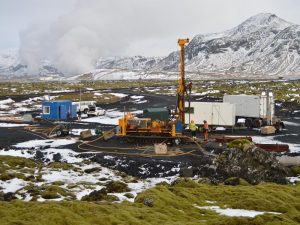Iceland Carbon Capture Project
Read the full article on http://www.smithsonianmag.com/
 “A pilot project that sought to demonstrate that carbon dioxide emissions could be locked up by turning them into rock appears to be a success. Tests at the CarbFix project in Iceland indicate that most of the CO2 injected into basalt turned into carbonate minerals in less than two years, far shorter a time than the hundreds or thousands of years that scientists had once thought such a process would take.
“A pilot project that sought to demonstrate that carbon dioxide emissions could be locked up by turning them into rock appears to be a success. Tests at the CarbFix project in Iceland indicate that most of the CO2 injected into basalt turned into carbonate minerals in less than two years, far shorter a time than the hundreds or thousands of years that scientists had once thought such a process would take.
“This project shows that, in fact, CO2 most likely turns into carbonates in a relatively modest amount of time,” notes David Goldberg, a geophysicist at the Lamont-Doherty Earth Observatory of Columbia University who was not involved with the project. “That’s a significant outcome.” Most conventional carbon capture and storage projects inject liquefied carbon dioxide into sedimentary rocks, the type of rocks in which oil and natural gas are found. Because oil and gas companies have so much experience working with these types of rocks, they are a natural place to store CO2. But these types of formations can only store the gas, not turn it into rock. And there is always a danger that the gas could escape to the atmosphere and add to global climate change.
The mineralogy of basalts, though, is very favorable for locking up carbon dioxide, says Juerg Matter, a geochemist now at the University of Southampton who began working on the CarbFix project while at Lamont-Doherty. For carbon dioxide to transform into carbonate, the rocks into which the gas is injected need to have calcium-, magnesium- or iron-rich silicate minerals. A chemical reaction then occurs that converts the carbon dioxide and minerals into a chalky carbonate mineral. Sedimentary rocks don’t have much of those minerals, but basalts—a type of volcanic rock that makes up most of the ocean floor as well as rocks on some other places on land—have plenty. Scientists figured that they should be able to lock away CO2 in such rocks as carbonate, but first they had to prove that it would work—and on a reasonable timescale.”


